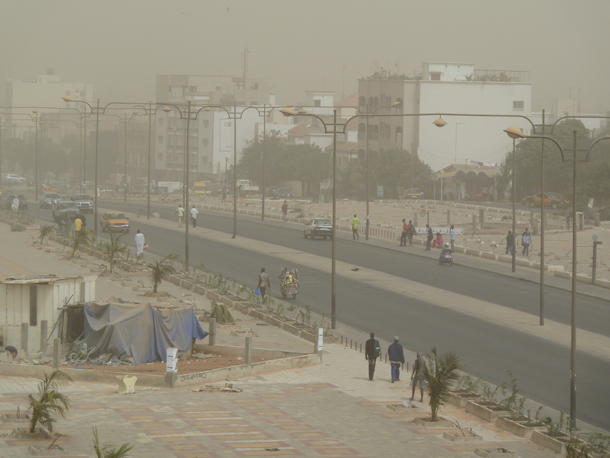Notes from Senegal. Africa's Great Green Wall of Trees.
Published: February 6, 2018
By Bobby Bascomb

The air is sometimes so thick it's hard to breathe - or see further than the next block. (Photo: Bobby Bascomb)
LOE's Bobby Bascomb is in Senegal, reporting on an ambitious plan to halt the shifting Sahara in its tracks. Here's her first blog.
The capital city Dakar sticks out into the Atlantic like a small thumb on the fist that is Senegal. Though it’s February, outside my hotel stands a fake Christmas tree, at least 8 feet high, covered in a thick layer of dust - or more accurately, sand. The west African trade wind is blowing south from Mauritania and bringing the Sahara Desert with it. It’s a winter weather phenomenon called the Harmattan, and it's kicking up the worst sand haze in years. Today the air is so thick with fine sand that's blown nearly a thousand miles from the Sahara, it's hard to breathe.
|
|
The steady advance of the desert is a serious problem in Africa's Sahel region. This dry grassland forms the boundary between the Sahara to the north and the equatorial jungles to the south. A drier climate and the creeping desert make it increasingly difficult for farmers to grow crops. Food insecurity and hunger have become a way of life, so Sahel countries are pinning their hopes on the Great Green Wall.
The Great Green Wall will be a 5000 mile wall of trees, 9 miles wide, stretching from Senegal to Djibouti. It’s intended as a physical barrier to block the steady advance of the Sahara desert but its success depends on the cooperation of the 11 nations along its path. And communities that have agreed to plant the trees need to nurture them.
After Dakar I’m visiting communities that have already planted trees for the Great Green Wall. I have many questions: How do they keep trees alive in this harsh environment? How have people’s lives changed as a result? Do they believe in this endeavor - and can it work? For the people whose homes lie in this harsh but fragile environment, those questions are a matter of life and death.
Bobby Bascomb's reporting trip to Senegal's Great Green Wall was made possible by a grant from the Pulitzer Center for Crisis Reporting.
Back to Africa's Great Green Wall of Trees
Living on Earth wants to hear from you!
Living on Earth
62 Calef Highway, Suite 212
Lee, NH 03861
Telephone: 617-287-4121
E-mail: comments@loe.org
Newsletter [Click here]
Donate to Living on Earth!
Living on Earth is an independent media program and relies entirely on contributions from listeners and institutions supporting public service. Please donate now to preserve an independent environmental voice.
NewsletterLiving on Earth offers a weekly delivery of the show's rundown to your mailbox. Sign up for our newsletter today!
 Sailors For The Sea: Be the change you want to sea.
Sailors For The Sea: Be the change you want to sea.
 The Grantham Foundation for the Protection of the Environment: Committed to protecting and improving the health of the global environment.
The Grantham Foundation for the Protection of the Environment: Committed to protecting and improving the health of the global environment.
 Contribute to Living on Earth and receive, as our gift to you, an archival print of one of Mark Seth Lender's extraordinary wildlife photographs. Follow the link to see Mark's current collection of photographs.
Contribute to Living on Earth and receive, as our gift to you, an archival print of one of Mark Seth Lender's extraordinary wildlife photographs. Follow the link to see Mark's current collection of photographs.
 Buy a signed copy of Mark Seth Lender's book Smeagull the Seagull & support Living on Earth
Buy a signed copy of Mark Seth Lender's book Smeagull the Seagull & support Living on Earth


